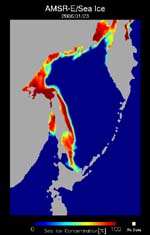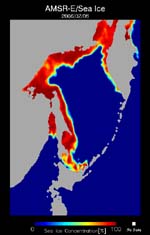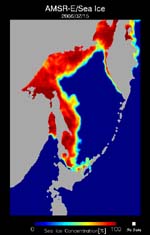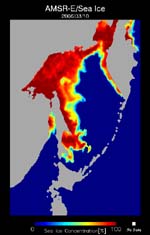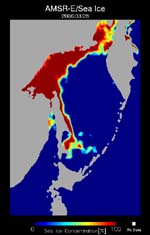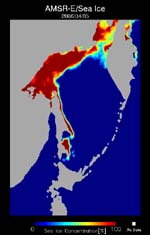Seen from Space 2006
Sea Ice Distribution in the Sea of Okhotsk during 2005 - 2006 Winter
This year, the total amount of sea ice in the Sea of Okhotsk is less than that of an average year. According to the statistics of the Japan Meteorological Agency, especially from December 2005 to January 2006, the amount sea ice there was the lowest since 1971. Sea ice forms a barrier between seawater and the atmosphere and reflects sunlight four to eight times better than the open sea. It therefore influences the exchange of heat and water vapor between the ocean and the atmosphere. Sea ice extent is being reduced by global warming and is a major factor in global climatological change. Observation of sea ice is thus becoming more and more important. But the sea ice in this season approached the Hokkaido coast almost as fast as in an average year. For example, Abashiri City on the Sea of Okhotsk recorded the first sighting of drift ice on January 23, 2006 (the first day drift ice is observed from land), and on February 6, 2006, it recorded the "First date of drift ice on shore" (the first date the drift ice covers the coast and ships are unable to navigate). After that, the sea ice weakened, and the drift ice on shore didn't last. On February 25, Abashiri City observed the "First date of shore lead appearance," which is the first date a channel appears and ships are able to navigate again. Furthermore, March 25 was the "Last date of drift ice in sight," which is the last date drift ice observed from land, was observed. Both the "First date of shore lead appearance" and "Last date of drift ice in sight" were much earlier than in an average year. As a result, drift ice tourist ship "Aurora," which operates from Abashiri City, saw its passengers decline more than one-third compared to last season. The drift ice tour industry is thus in a depression, and local economies have been greatly damaged. In contrast, drift ice was first observed from land in Wakkanai City on April 5, some 54 days later than in an average year (on February 11), making it the latest sighting since 1946. It is thought that the ice was near the southeastern tip of Sakhalin Cape Aniva on March 28 and that part of it moved to the west. Drift ice or icebergs are very dangerous for ships, as demonstrated by the Titanic disaster in 1912. The Japan Coast Guard and the Japan Meteorological Agency therefore publish drift ice information for ships navigating around northern Japan. AMSR-E data is one observation source for this information. Sea ice influences not only the climate and meteorology but also human industrial activities such as fisheries, marine traffic, and tourism.
|
|||||||||||||||||||||||||||
